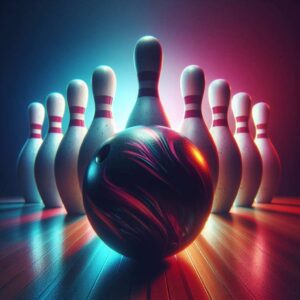Bowling is enjoyed by over 70 million Americans each year, but approximately just 10% of people are left-handed. While right-hand dominant people can easily find instruction tailored to them, resources for left-handed bowlers are surprisingly sparse. However, mastering proper left-handed bowling form is not extremely complex with the right guidance.
In this extensive guide, we provide left-handed bowling tips for beginner to advanced players on topics like:
- Optimizing stance, footwork, and release
- Matching equipment to your left-handed swing
- Aiming techniques and hitting your target
- Analyzing misses and making adjustments
- Improving consistency with drills
- Equipment considerations and customization
- Training games and practice approaches
Follow these specialized southpaw bowling tips correctly, and you’ll have the tools to excel regardless of being left-hand dominant.
The Left-Hand Bowler’s Stance and Approach Differ from Orthodox Forms
Most generic bowling advice is geared towards right-handed players without considering the perspective and technique changes needed for lefties. But your setup and approach angle will be mirrored opposites.
Proper Stance Placement
Firstly, your starting position and side will be switched. Stand to the left of the ball and return with your body squared up to the pins. Plant your right foot first instead of your left. This opens up your torso naturally to the lane for your swing.
Footwork and Steps
As a lefty, your first step will be with your left foot which is the opposite of a conventional approach. Adjust your strides so they finish at the foul line properly without overextending. Let your arm swing control foot speed rather than rushing steps.
Shifting Perspectives
Your outlook on the lane differs from most players. Visualize the angle of approach the ball takes from the left gutter. This perspective lets you view the designed hook potential based on the oil pattern.
Adjusting Aim and Curve
The ball rotation and curve will bend in the opposite direction you’re used to seeing others throw. So move your initial starting position and visual targets to account for the reversed hook. Aiming dots left of the center can be your guide.
Release and Follow Through
Since your dominant hand is on the backswing, the timing and position of your release differ too. Roll off your thumb first allowing your fingers to impart revolutions on the ball. Follow through straight towards your target without crossing over.
Making Proper Adjustments for Left-Hand Dominant Bowling
Reading lane oil patterns and making moves left or right is crucial for bowling success. This is especially true for lefties as typical breakdowns happen in reverse.
Matching Ball to Bowling Style
Choosing the right reactive resin ball is imperative to maximize striking. Talk to pro shop staff about getting fitted for a hook potential that complements your curve, speed, and rev rate as a lefty bowler.
Understanding Lane Oil Breakdown
The section of burnt or carry-down oil you see right-handers playing is the opposite for you. Move left and observe transitions around the second arrow to avoid over or under the hook. Vary angles until discovering the ideal line.
Shifting Your Adjustments
As lanes start transitioning, analyze the fronts, mids, and backs to determine optimal relocation spots. Analyze by moving feet or targets incrementally left to handle changing contexts from one game to the next.
Cleaning Equipment Properly
Left-hand oil residue alters ball motion more rapidly. Utilize microfiber towels between shots and ensure a proper surface prep process before matches to avoid over or under-response.
Improve Aim and Accuracy With These Left-Handed Bowling Tips
Successfully hitting the pocket involves mastering speed, revs, timing, and accuracy of release. But reading lane oil transitions and other visual targeting processes differ slightly for lefties.
Utilizing Guide Arrows and Dots
Most house patterns have directional arrow guides. Use the left set of arrows to direct your shot into the pocket smoothly and repeatably every time. The dots left of the center also assist.
Setting Visual Targets
Beyond arrows and dots, create targets using back row pins or board lines as ways to improve accuracy. Pick reference points and markers specific to lefty perspective and angles. Move lateral starting positions as necessary.
Analyzing Your Miss
When you leave splits or gutter frequently, don’t just make random adjustments. Break down the angle of entry, speed, release point, and curve visually to make appropriate and incremental changes.
Consistency Drills
Improving accuracy involves specialized drills like slide-only reaches, no-step releases, swing plane checks, standstill targeting, and resetting hand positions after misses until consistency takes hold.
Optimizing Equipment Considerations and Specs for Lefties
Specialized equipment designed and fitted specifically according to left-handed swing dynamics can give you a leg up. Talk to pro shop staff about key specs and custom options.
Getting Fitted for Left-Hand Shoes and Gloves
Slide, traction, and toe stoppers differ for lefty footwork. Ensure shoes properly fit your specific needs. Gloves worn on your dominant hand also benefit from left-handed sizing for comfort and flexibility.
Testing Ball Weights and Finger Positions
Experiment with lighter or heavier core weights to find the optimal ball reaction. Also pay attention to proper finger span positions for your rev rate, speed, and release style when drilling custom balls.
Pursuing Full Custom Bowling Balls
General production balls involve static specs to appeal to most players. But investing in fully custom balls with lefty-specific cores, materials, finishes, and engraving takes personalization up a notch.
Specialized Practice Games and Drills for Southpaw Bowlers
Standard bowling practice tends to overlook left-handed physiological needs. But these asymmetric drills and training games will get you results.
Fun Lefty Targeted Practice Games
Incorporate specialized scoring, aim challenges, and pacer tools into your training games. Compete against other lefties when possible to motivate skill improvement.
Conquering 7-10 Splits
these notorious splits plague lefties disproportionately. Spend extra time perfecting precision targeting and speed control required to pick them off regularly.
Using Adjustable Training Aids
Take advantage of adjustable slide trainers, release tools, wrist devices, and swing plane aids that can adapt to left handed players for ingraining proper technique.
Proper Form and Release Fundamentals
Finally, don’t neglect the importance of honing fundamental physical repeatability for consistency. Pay attention to hand positions, angles of release, and key pillar aspects below.
Hand and Wrist Alignment
Ensure ideal hand position inside the ball with proper lifting using your ring and middle fingers. Bend the wrist slightly to prevent tension and encourage free release.
Backswing and Timing Optimization
Visualize the swing plane and adjust shoulder rotation to achieve perfect 5-step timing. Rush approaches and throws everything out of whack. Smooth tempo aligns slide foot and arm in synch.
Analyzing and Correcting Release Issues
Asymmetrical issues like opening up early, crossing over, or lifting can plague lefties. Self-diagnose and drill correct thumb exits, rolls, and follow-through angles tailored to being left-hand dominant.
Take Your Game to the Next Level Using These LHD Bowling Tips
In this guide, we explored specialized left-hand bowling tips covering unique stance considerations, angle approaches, breakpoint analysis, ball specs, releases, practice drills, and more tailored precisely according to left-hand dominant bowler challenges and perspectives.
While mastering bowling competency presents learning curves for any new player, lefties face additional physiological equipment and technique challenges requiring dedicated adaption.
By applying these expert southpaw bowling methods to your game though, rapid skill development is completely achievable if you put in the work.
The advantage the best left-handed bowlers have is understanding just how asymmetry impacts performance, and adjusting appropriately. So utilize these tips during your next practice session, tournament, or friendly righty vs lefty matchup!
Frequently Asked Questions
How do I get better at left-handed bowling?
To improve as a left-handed bowler, focus on optimizing your stance, timing, release, and adjustments specific to the left-hand dominant technique. Drill targeting consistency, study oil patterns from a lefty perspective, get fitted equipment, and use adjustable aids to ingrain proper physical forms.
Is it harder to bowl left-handed?
Bowling left-handed introduces some unique challenges compared to right-handed bowling. Equipment, instructions, and technique perspectives tend to favor orthodox players. However, with practice adjusting aim, release, ball layouts, and footwork to lefty physiology, skill mastery is achievable.
Where should a left-handed bowler line up?
Left-handed bowlers should line up on the left side of the lane, using the left set of arrows to aim their shot. The exact starting board depends on your specific hook potential and angle, usually around boards 23-27.
How do you throw a left-handed hook in bowling?
To generate an effective lefty hook, use the proper axis rotation and lift by leading with your thumb and rolling over your fingers through release. Adjust wrist position, and timing, and align your swing plane angle to impart the desired revolution for striking.
What percentage of professional bowlers are left-handed?
Only around 10 percent of professional bowlers are left-handed, though some all-time greats of the sport like Mike Aulby, Earl Anthony, and Mark Williams have been southpaws showing high skill ceilings. The rarity of lefties underscores the practice adjustments needed.
Can left handers bowl off spin?
Yes, left-hand dominant bowlers in cricket can bowl with wrist spin to create off-spin. The angles and grip differ from right-armed leg spin somewhat, placing emphasis on strong finger flick capabilities. Left-arm orthodox spin comes more naturally to most.
Do left-handed people have a disadvantage at bowling?
Left-handed bowlers don’t inherently have a disability, but do require specialized equipment, instruction, and technique tweaks accounting for the asymmetry compared to righties. Understanding these adjustments minimizes any disadvantages.
What is a left-handed bowler called?
Left-handed bowlers are sometimes referred to as southpaws, a term originating from baseball but adopted across other lefty-slanted sports like bowling as well. The word playfully underscores the angle change.
Why do lefties throw slower?
Left-handers aren’t intrinsically slower, though adjusting timing and footwork rhythm to a mirrored stance can pose initial challenges requiring refinement through tailored drills. Properly aligning approach and release smoothes out velocity.





